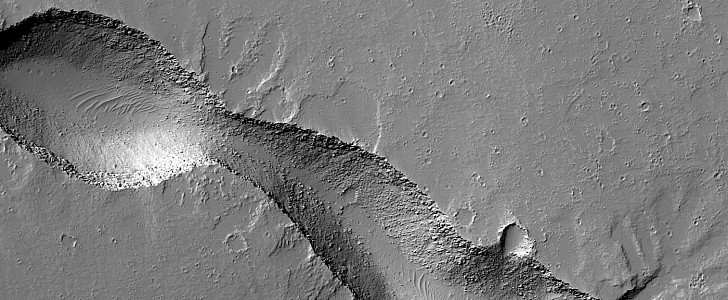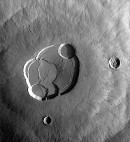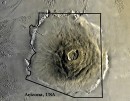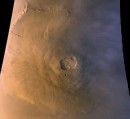I am not sure I personally see it that way, but according to NASA and University of Arizona scientists, if you look at this image in the right way and with an open mind, you might see “a gecko with its long tail and web-shaped feet!”
The shape is, of course, anything but a gecko. Like the entire planet of Mars, it’s not even alive, but rather a geological feature transformed into something our brains can process by that little something called pareidolia – the habit of the human mind to see familiar images and patterns where there are none.
As is, this is just a large fissure on the surface of Mars, as seen from an altitude of 273 km (170 miles) by the HiRISE camera that orbits the place on board the Mars Reconnaissance Orbiter. The image was captured back in August, and only recently made public by the people who run the hardware.
The fissure is located in Gordii Fossae, a volcanic region near Olympus Mons, the largest volcano on the planet. We’re told this is an usual occurrence in the area, big cracks disrupting smooth volcanic surfaces.
Scientists suspect the crack appeared “when underground faults, possibly involving magma movement, reach the near-surface, allowing material to collapse into pits or an elongated trough.” The particular one we have here “appears to have erupted material that flowed onto the surface.”
However it may have formed, the volcanic gecko came to be a long time ago. In the present, Mars has no volcanic activity, but it once did, and quite a lot of it. Thanks to its tumultuous past, we modern humans have the chance of really taking a look into the place’s past, hoping to uncover the secrets that would allow us to call it our second home in the future.
As is, this is just a large fissure on the surface of Mars, as seen from an altitude of 273 km (170 miles) by the HiRISE camera that orbits the place on board the Mars Reconnaissance Orbiter. The image was captured back in August, and only recently made public by the people who run the hardware.
The fissure is located in Gordii Fossae, a volcanic region near Olympus Mons, the largest volcano on the planet. We’re told this is an usual occurrence in the area, big cracks disrupting smooth volcanic surfaces.
Scientists suspect the crack appeared “when underground faults, possibly involving magma movement, reach the near-surface, allowing material to collapse into pits or an elongated trough.” The particular one we have here “appears to have erupted material that flowed onto the surface.”
However it may have formed, the volcanic gecko came to be a long time ago. In the present, Mars has no volcanic activity, but it once did, and quite a lot of it. Thanks to its tumultuous past, we modern humans have the chance of really taking a look into the place’s past, hoping to uncover the secrets that would allow us to call it our second home in the future.






